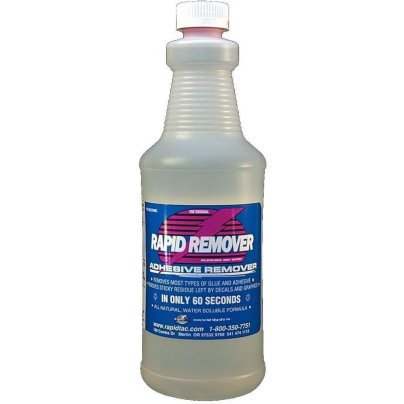
We may earn revenue from the products available on this page and participate in affiliate programs. Learn More ›
Goopy, waxy, oily, or just plain annoying, stickiness can be caused by grease, wax, tape,glue residue, decals, and even certain foods in different areas of the home. But the right adhesive remover will save surfaces from ruin—and will spare users time and extra effort. Most removers break down the molecular bonds that make sticky products, well, sticky. To physically remove stickiness, buyers can invest in a well-designed scraper tool.
Choosing the right adhesive remover for a sticky situation is half the cleanup, so check out our shopping considerations and recommendations for products covering most home and garage needs.
- BEST OVERALL: Goo Gone Original Liquid
- UPGRADE PICK: Un-Du Formula Sticker, Tape, and Label Remover
- BEST FAST-ACTING: RapidTac Rapid Remover Adhesive Remover
- BEST FOR TOUGH MESSES: 3M General Purpose Adhesive Cleaner
- BEST FOR OIL AND GREASE: Oil Eater Original Cleaner and Degreaser
- BEST FOR VEHICLES: Custom Shop Automotive Grease and Wax Remover
- BEST TOOL: ABN Long Reach Razor Blade Scraper
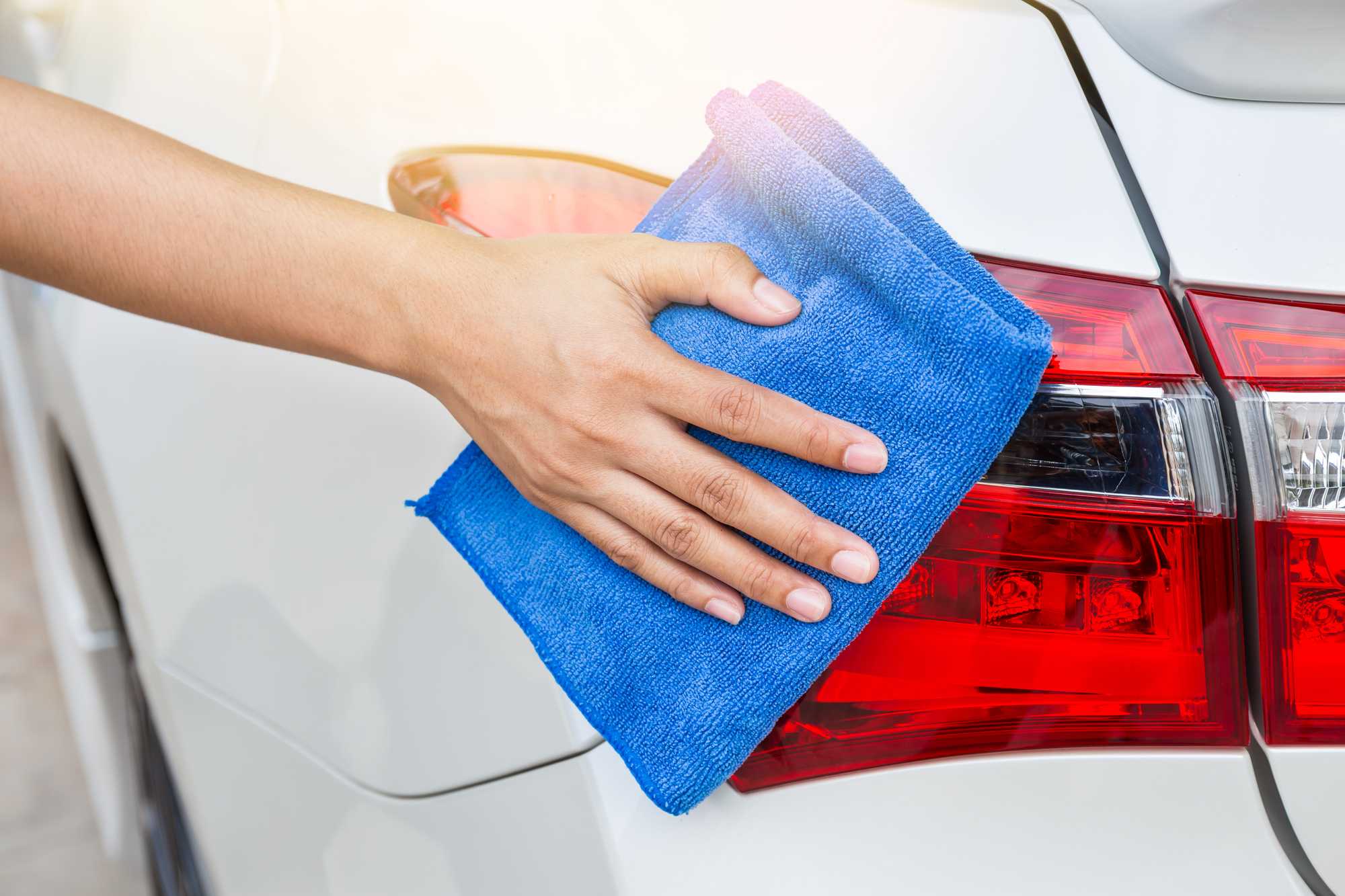
Types of Adhesive Removers
To ensure users get the results they are looking for, they will need to find the proper formula for the adhesive that needs to be removed. The best rule of thumb is to try the least-harsh option before resorting to heavy-duty solvents.
Citrus-Based Removers
Citrus-based removers contain a mixture of citrus-fruit extract and propane as their main ingredients. These products may also include chemicals such as chloride, halogen, sulfur, and fluoride. Best for common household messes, citrus-based removers are great for mild to moderate adhesive residue (e.g., tape, stickers, and cooking oil). They can also help fight grime in kitchens and bathrooms.
Soy-Based Removers
Soy-based removers use soybean oil and propane as their active ingredients. Soy is often used in industrial- and professional-grade products. Stronger than citrus-based products, soy-based removers are good for loosening old tacky bonds. Think mastic adhesives (a gumlike substance used for tile work) and glues holding down old carpeting. Soy-based removers may require several hours to soften old glue residue sufficiently. Once you scrape the surface clean, the remover should dissolve with water and soap.
Solvent-Based Removers
Solvent-based removers are the strongest on the market. They penetrate surfaces to break chemical bonds and erase any residue. Active ingredients can include harsh and potentially caustic chemicals such as xylene, ethylbenzene, toluene, benzene, methanol, and naphtha, a petroleum-based chemical often used to clean metal.
These chemical solvent adhesive removers should be handled with care and according to instructions. Use only if absolutely necessary and when other methods have failed. Some of these products contain a specific warning about ethylbenzene, which may cause cancer, and methanol, which has been linked to birth defects and reproductive harm, according to the State of California.
“Greener” Adhesive Removers
“Greener” adhesive removers are being developed because of increasing concerns over health, safety, and climate change. More companies are inventing products marketed as “biodegradable” and “nontoxic.” Being relatively new on the market, these products for now lack widespread consumer and expert reviews vouching for their effectiveness.
According to the Environmental Working Group, complete lists of ingredients for these products can be hard to find, so caution is still needed when considering these products. For those reasons, we omitted natural adhesive removers from our “top picks” below; however, they are worth keeping an eye on.
What to Consider When Choosing the Best Adhesive Remover
Household adhesive removers come in three main formulas: citrus-based, soy-based, and solvent-based (although we also have some research into greener products that may be a good alternative for households cutting back on the use of harsh chemicals). When comparing options, remember to consider the type of mess, the surface material, and the ideal application method.
Surface Type
Stickiness can damage surfaces—but so can the wrong product! Always choose a formula that lists itself as “safe to use” or designed for your particular surface, be they fabrics, finished wood, sealed stone, automotive parts, or flooring.
In addition to surface type, consider the type of adhesive. Certain adhesives are more difficult to remove than others. These are called “reactive adhesives” because they contain a chemical hardener to make a secure bond. Reactive adhesives can be used to secure vinyl flooring, as well as fasten decals and wheel weights on vehicles. They are made of resin and a hardening agent. In this case, users will need a product that can break down these strong bonds, typically a solvent-based remover.
Application Method
Users can remove adhesive in one of three ways or by mixing and matching to get the desired results.
- Spraying is best for covering larger surface areas. Most spray-on formulas come in a spray bottle or an aerosol can. Always work in a ventilated room or outdoors, and wear protective gear, such as goggles, rubber gloves, and a surgical mask.
- Soak and wipe away liquid adhesive removers, which users can control by applying with a paper towel or a cotton swab. This is especially helpful when dealing with more delicate materials (e.g., certain fabrics or antiques) and when aiming to use as little chemicals as necessary.
- Scrape adhesive residue from certain hard surfaces such as glass and tile. You’ll need the right tool and a little soapy water; however, don’t use just any sharp edge. Specially designed scrapers come in both metal and plastic blades, so users won’t damage the surface.
Our Top Picks
Now that we’ve learned more about adhesive removers, it’s time to start shopping. The following are the top picks for the best products to remove adhesive and get rid of sticky residue.
Best Overall
Goo Gone Original Liquid
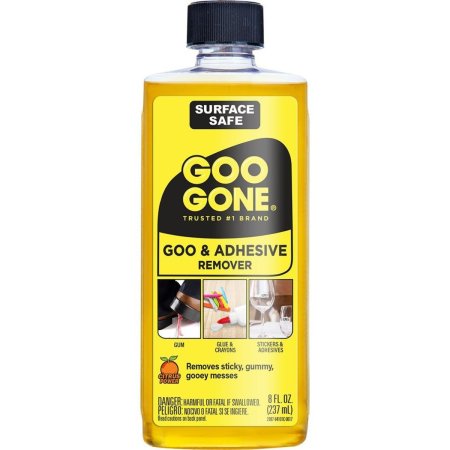
Pros
Cons
Product Specs
- Type: Citrus-based
- Application method: Soak and wipe away
- Quantity: 8 ounces
Goo Gone
’s bright-yellow liquid is still the gold standard for eliminating sticky household messes. The citrus and petroleum–based formula is safe on most hard surfaces, but be careful with rubber and delicate fabrics: Goo Gone can deteriorate these materials.
For cars, the company suggests spot-testing the formula in an unobservable place before using it to remove decals or other tacky residue from your vehicle. The reason for its “trusted # 1” status is simple: “It works brilliantly,” according to Amazon customers. Goo Gone can remove stickers; wax, marker, and crayon residue, as well as glue residue; tar; decals; glitter; gum; labels; and more. Apply with a paper towel or cotton swab. There is also a
of the same original formula.
Get the Goo Gone adhesive remover on Amazon or at The Home Depot.
Upgrade Pick
Un-Du Formula Sticker, Tape, and Label Remover
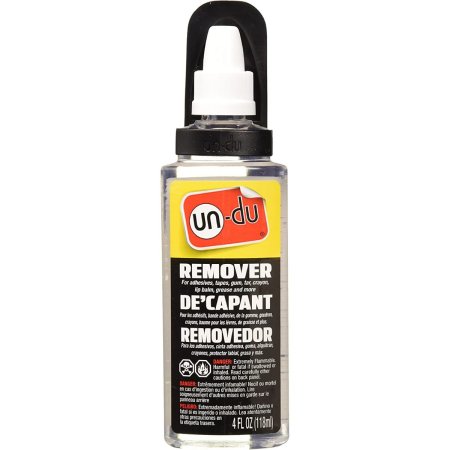
Pros
Cons
Product Specs
- Type: Solvent-based
- Application method: Soak and wipe away
- Quantity: 4 ounces
When other products have failed to work, it’s time to bring in the big guns: chemical solvents. Un-Du is a solvent-based adhesive remover that is safe to use on plastic, glass, metal, paper, walls, carpet, most furniture, most clothing, and more. The bottle comes with an attached scraper, meaning users don’t need to use another tool to scrape stickers or sticky residue away.
As an impressive added feature, stickers can actually be reused after they’ve been removed because Un-Du doesn’t permanently damage their adhesive backing. Simply give them time to dry, and use them again as needed. It’s important to note that because of its chemical makeup, this product cannot be sold in the state of California.
Get the Un-Du adhesive remover on Amazon.
Best Fast-Acting
RapidTac Rapid Remover Adhesive Remover
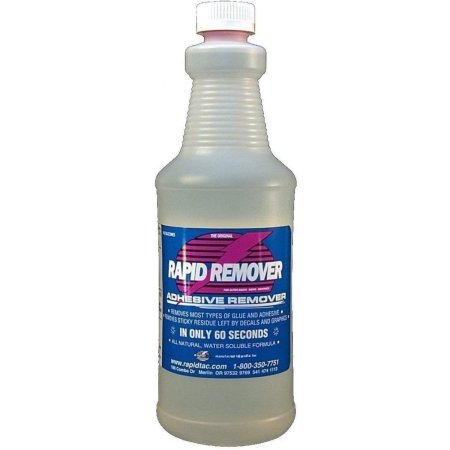
Pros
Cons
Product Specs
- Type: Solvent-free
- Application method: Spray
- Quantity: 32 ounces
For larger stickers and decals, a fast-acting spray solution is an ideal choice for quick removal. This product comes in a 32-ounce spray bottle that can be applied liberally and takes less than a minute to work its magic. It’s designed for hard surfaces such as metal and glass, and for other painted surfaces. It shouldn’t be used on soft surfaces such as carpeting, clothing, or upholstery.
To use, spray the affected area with the solution and wait for 30 to 60 seconds. Then, depending on the strength of the adhesion, either scrape it off with a scraping tool or wipe it away using a cloth or paper towel.
Get the RapidTac adhesive remover on Amazon.
Best for Tough Messes
3M General Purpose Adhesive Cleaner
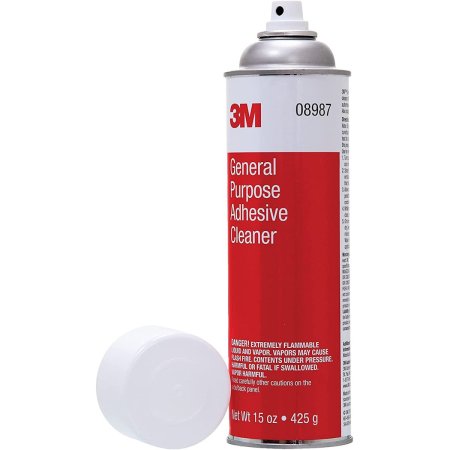
Pros
Cons
Product Specs
- Type: Solvent-based
- Application method: Spray
- Quantity: 15 ounces
For heavy-duty messes, 3M’s General Purpose Adhesive Cleaner is the best bet. Solvent-based adhesive removers such as this one are blended to remove light spray paint, adhesive residue, wax, grease, tree sap, road tar, oil, and bugs (such as the ones cemented to car windshields and bumpers). It is also an aerosol formula, which has certain health, safety, and environmental risks.
Users will need to use caution and work in a ventilated space with the proper safety gear (e.g., gloves, goggles, mask). We recommend this product especially for automotive and garage use, as it will not damage paint, vinyl, or fabric.
Get the 3M adhesive remover on Amazon.
Best for Oil and Grease
Oil Eater Original Cleaner and Degreaser
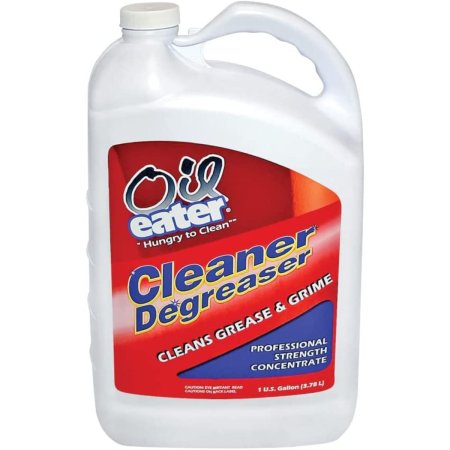
Pros
Cons
Product Specs
- Type: Solvent-free
- Application method: Soak and wipe away/spray
- Quantity: 1 gallon
Oil stains can be tough to get out. In dealing with dark, oily marks on driveways, garage floors, or living room carpets, Oil Eater’s liquid degreaser is gentle yet effective, acting as a powerful floor adhesive remover. It is USDA-approved for nonfood surfaces and contains no acids or petroleum-based solvents (2-butoxyethanol is the main active ingredient).
Oil Eater is also compliant with the standards set by California’s South Coast Air Quality Control Board. Simply dilute this concentrated liquid with water as needed for oil spots on laundry, floors, carpets, tub/tile areas, grills, decks, asphalt, concrete, and more.
Get the Oil Eater adhesive remover on Amazon.
Best for Vehicles
Custom Shop Automotive Grease and Wax Remover
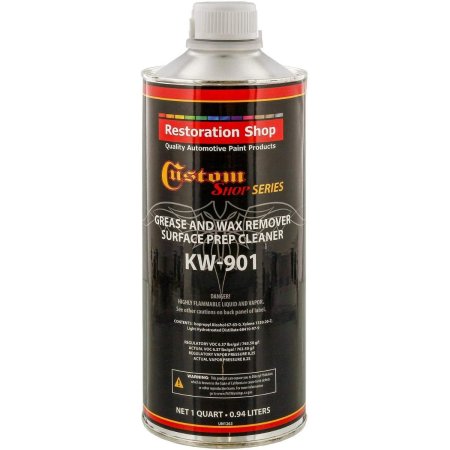
Pros
Cons
Product Specs
- Type: Solvent-based
- Application method: Spray
- Quantity: 32 ounces
At-home mechanics can give their vehicles a professional clean with Custom Shop Automotive Grease and Wax Remover. This solvent-based spray works well on painted surfaces, metal, plastic, epoxy, and fiberglass. It dries quickly, removes car wax, and is the perfect prep before retouching a vehicle. Application is simple: Spray onto a clean, lint-free cloth, and use a separate wet cloth to wipe off any residue.
This product works to remove grease, wax, tar, sap, silicones, and more. Be careful when using it on interior surfaces, however, as the formula is not designed for plastic polymers, leather, or softer fabrics.
Get the Custom Shop grease and wax remover on Amazon.
Best Scraper Tool
ABN Long Reach Razor Blade Scraper
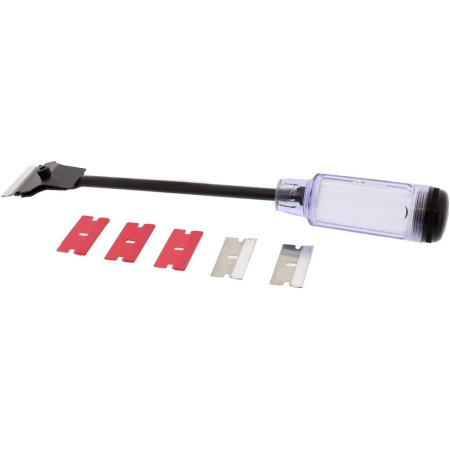
Pros
Cons
Product Specs
- Type: Scraper
- Application method: N/A
- Quantity: N/A
To clean hard, slick surfaces, users need the right tool for the job. With ABN’s 11-inch Long Reach Razor Blade Scraper, users can erase stickiness and reveal spotless windows, mirrors, and tile. The long handle gives users extra leverage for removing paint, decals, labels, or automotive detailing—even in hard-to-reach places.
Blade replacement is easy, too: Just twist the screw-spring release and change the blade. It fits all standard replacement razors. Each tool comes with three plastic blade replacements and two steel blades.
Get the ABN razor blade scraper on Amazon.
Our Verdict
After reviewing this guide, prospective buyers now know more about shopping for the best adhesive removers. We recommend the Goo Gone adhesive remover as our top pick because it’s both safe and effective. Those who need a stronger solvent-based product will appreciate the powerful performance of our upgrade pick, the Un-Du adhesive remover.
How We Chose the Best Adhesive Removers
Years of experience covering home and cleaning products as well as extensive product research went into creating this guide. We explored more than 20 adhesive remover options and weighed several practical considerations before making our recommendations.
We aimed to include many different formulas in order to best suit the majority of shoppers. We opted to recommend both solvent-based and solvent-free formulas as well as products designed for a wide variety of surface types. We omitted products marketed as being “green” or “eco-friendly” due to a lack of scientifically backed research.
FAQs
Prospective buyers now know more about the best adhesive removers for getting rid of sticky substances but might still be looking for more information on how to use them. Here are answers to some of the most frequently asked questions regarding products designed to remove adhesive.
Q: How do you remove adhesive from glass?
All the products we recommended are safe to use on glass surfaces.
Q: What dissolves sticky adhesive?
Several ingredients break down adhesive chemicals, including petroleum, citrus, soy, and solvents.
Q: Does WD-40 remove adhesive?
Although removing adhesives may not be the primary use of WD-40, it actually acts as an excellent adhesive remover.
Q: What removes sticky residue naturally?
Reliable commercial products that remove sticky substances naturally can be hard to come by, so many opt for DIY solutions such as olive oil, mayonnaise, peanut butter, and baby oil.


